St James Learning and Teaching
Curriculum / Classroom News

St James Learning and Teaching
Curriculum / Classroom News
Alice in Wonderland
Recently I read the story Alice in Wonderland to my two daughters. I have often been slightly repulsed by Alice in Wonderland as I assumed it was always a story that originated from psychedelic drugs, as alluded to by the drink me bottle and eat me biscuits throughout the story.
But this time I was awakened to the complexity of the story and it’s relevance to teaching our children to mature.
The first point of interest that I didn’t notice before was the very beginning of the story. It starts with Alice’s older sister wanting to read to Alice historical stories of Kings (which sounds like it could be the Bible). But immediately Alice is not interested as were we when we were kids. People from long ago are too removed from our own lives as kids, which is more entertained by whims and curious things, or wonderlands. Alice wanted something else, stating “in my world there would be no lessons. All would be nonsense.”
Alice was really abandoning the world of making sense of things, to journey into the land of nonsense. Because sense was too boring, she didn’t want another history lesson, what for. What she wanted was nonsense, she wanted experience, something to feel.
I am reminded of my own daughters most recent request: “Dad do a silly dance in front of me”. Of course I entertained her request much to her delight. Kids love nonsense.
By the end of Alice’s journey when she is sentenced to being beheaded she was not so keen on nonsense anymore or experiencing anything like that.
Because nonsense was the major theme of Wonderland, which is fine when dealing with things like tiny doors with door knobs that talk, it starts to get uncomfortable when you meet two men in a dark forest who offer no help of direction or at parties where unbirthdays are celebrated. It gets very dangerous when the ruling power, the Queen of Hearts, is governed by nonsense while her little King, perhaps the only character who speaks sense, tries to remind her of the rights of the accused when performing justice.
It is interesting that this land of nonsense, in order to enter, you have to become smaller while floating on unmet child tears of seeking something that tickles ones curiosity. Certainly the opposite of what it is to become mature.
What I also found out that makes this the story of Alice more meaningful, is that the author Lewis Caroll was a mathematician and logician. He made up the story to entertain some children on a boat journey. His aim though was to come up with something completely nonsensical. But what birthed from his unconscious was perhaps the most perfect story to explain the journey of a child from immaturity to maturity, while also explaining where some children get stuck in immaturity. Whether it is the banter and nonsensical dialogue of Tweedledee and Tweedledum, the endless tea party and singing of the Mad Hatter and his friends, or worse the tyrannical authoritarian nature of the Queen of Hearts who is prone to mood swings and inflicts extreme punishments for minor offences. She represents the pinnacle of immaturity in authority.
By this stage of the story Alice has had enough of nonsense, she is ready to return to reality and to her sister's reading of history. For the real journey to maturity is realising how empty and frivolous the paths of immaturity are. They are rightly paths of nonsense, perhaps in a land of wonder but not in a good way. In fact what starts off playful and cute, following a rabbit down a hole, ends with extreme danger of loosing one's head. What this story shows. Is a warning to our children.
If they choose a life of following their own curiosity, it is never satisfied. There are characters in the world, men and women, who are ruled either by their own whims or desires to deceive, to trap and to dominate you or worse they are just indifferent to you like the Cheshire Cat. A life lived by nonsense will ultimately lead to disaster.
The happy ending of Alice in Wonderland, is she woke up!
She never took the journey to Wonderland, the land of nonsense and immaturity. She woke up to a desire to follow sense. Sense that can be found in knowledge, in understanding history, in understanding right choice and maturity. In discerning what is right over what is nonsense. Only in this way can a good society be built. Otherwise our children’s generation is going down the rabbit hole. We need to teach them before the queen of hearts does start to rule and then no one is safe.
Which makes me wonder have we already gone down the rabbit hole as a society?
The sign that we have is when those in authority are ruling by a desire to dominate and without good sense. Do you see this happening?
Let us get busy teaching our kids to live lives guided by sense. I have heard some families get into debating topics around the kitchen table, which sounds great. Even reading the bible stories which has lots of stories about kings as Alice’s sister was reading. What is interesting about the bible is that it has history that includes the success’s and the failings of the leaders. Normally the failings are not included in the history books. But even great kings fall to curiosity and nonsense, like King David and King Solomon of the Bible.
Also social media is governed by catching peoples curiosity. Perhaps this is a conversation you can have with your children. What are they curious about in life? What are somethings we shouldn’t be curious about? But also how much time do we spend on nonsense things. Because “I’m late” is a common theme running through Alice in Wonderland. We literally waste time on nonsense. Perhaps ask your child what is a good use of time? But be prepared they might ask for a silly dance.
Alice in Wonderland as a cautionary tale for children, urges them to navigate the complexities of life with discernment and maturity. It suggests that a fixation on curiosity and whimsy without regard for sense or consequence can lead to perilous outcomes and detrimental characters.
There is hope, when we teach our children to be mature.
Corey Payton
School Chaplain
Last week the Year 6 STEM Leaders ran STEM Club for all students. The students made creations with Strawbees and built towers with the planks. The STEM Leaders created challenges such as the tallest tower and the most impressive design. It was fantastic to have students from all year levels engaged in the activities and working together to problem solve and think creatively.
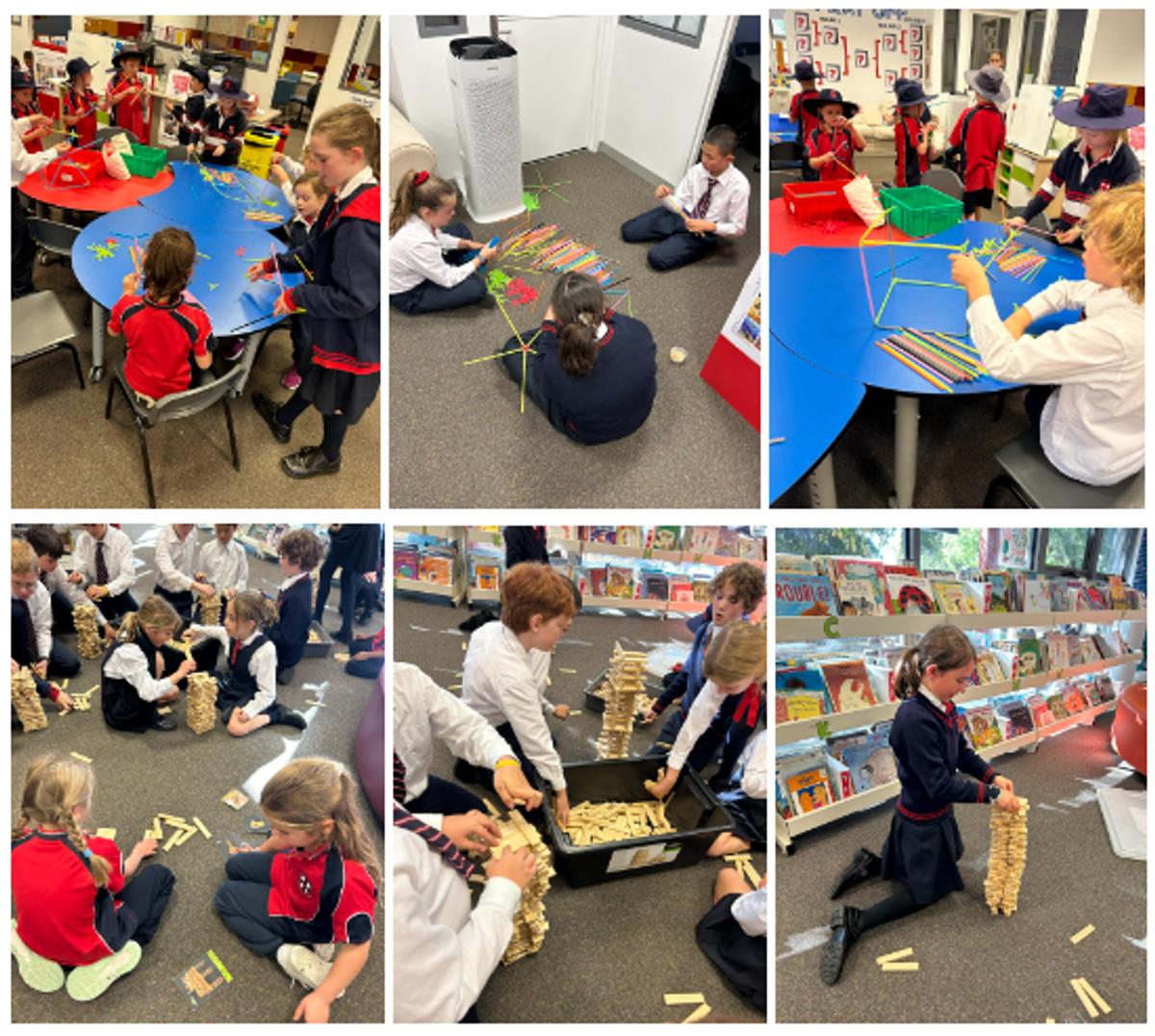

Miss Bridie Slater
STEM Leader
In library, we are constantly reviewing books and making recommendations. Book reviews are a great way to engage with your child about reading and practice a bit of writing about something they are interested in. Reading, writing and oral language all go hand in hand to making a successful learner.
So how do I write a book review?
Here are some top tips for how to write a brilliant review of the latest book you read - whether you like the book or not.
Other readers will always be interested in your opinion of the books you've read. Whether you've loved the book or not, if you give your honest and detailed thoughts then people will find new books that are right for them.
If you're stuck on what to say in a review, it can help to imagine you're talking to someone who's asking you whether they should read the book.
1. Start with a couple of sentences describing what the book is about
But without giving any spoilers or revealing plot twists! As a general rule, try to avoid writing in detail about anything that happens from about the middle of the book onwards. If the book is part of a series, it can be useful to mention this, and whether you think you'd need to have read other books in the series to enjoy this one.
2. Discuss what you particularly liked about the book
Focus on your thoughts and feelings about the story and the way it was told. You could try answering a couple of the following questions:
3. Mention anything you disliked about the book
Talk about why you think it didn't work for you. For example:
4. Round up your review
Summarise some of your thoughts on the book by suggesting the type of reader you'd recommend the book to. For example: younger readers, older readers, fans of relationship drama/mystery stories/comedy. Are there any books or series you would compare it to?
5. You can give the book a rating, like we do in library lessons. For example, a mark out of five or ten, if you like!


OVER THE NEXT FEW NEWSLETTERS WE WILL EXPLORE GRAPHIC NOVELS
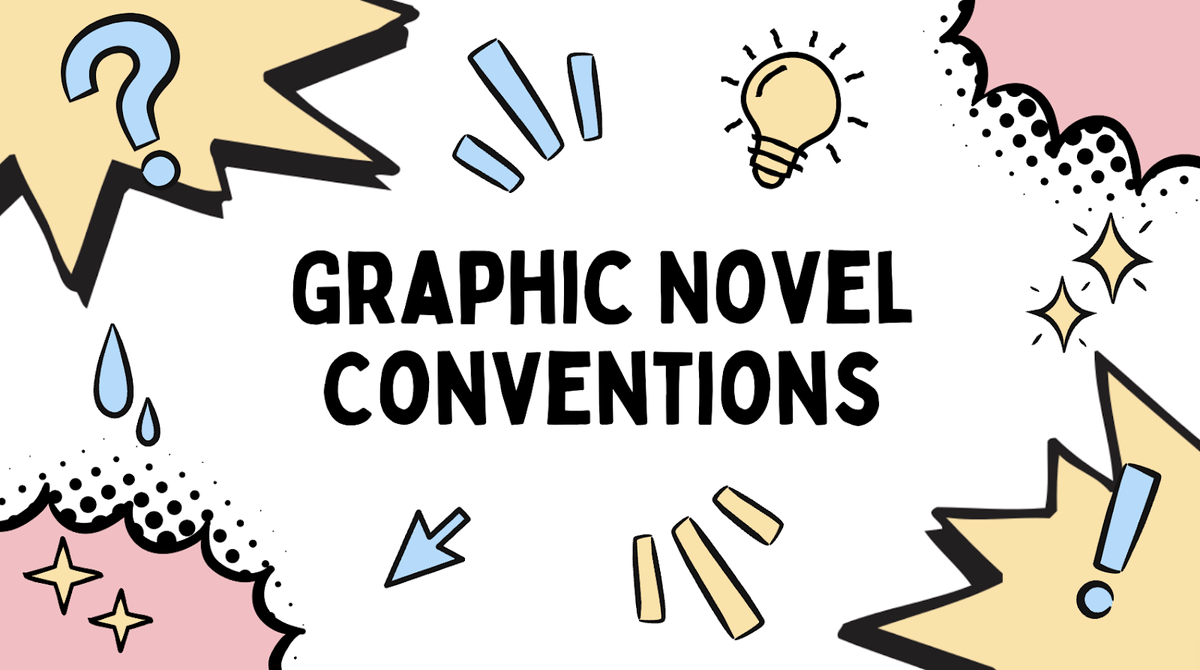

What is a graphic novel?
A graphic novel is defined as a form of long fiction that uses a sequence of images or illustrations to tell a story. A graphic novel can be a stand-alone story, or it can be an anthology collection of smaller issues of work.
Graphic novels vs traditional novels: What are the main differences between the two?
The most obvious difference between graphic novels and traditional novels is the inclusion of images. In a regular novel, the main story is told entirely through words. There may be some illustrations at the beginning of each chapter or scattered throughout the text, but they do not contribute to the storytelling and are used as an accompaniment or decoration.
A graphic novel, however, tells a story using text and imagery. There will be captions, dialogue or small inserts of text. The text included in graphic novels, will be in the form of speech, effect bubbles or scene indicators and short paragraphs to provide context.
Many children remark that their parents do not like them borrowing Graphic novels as there are not enough words, however contrary to this common belief Graphic novels actually encourage children to use a number of comprehension skills. GRAPHIC NOVELS ARE NOT COMIC BOOKS!
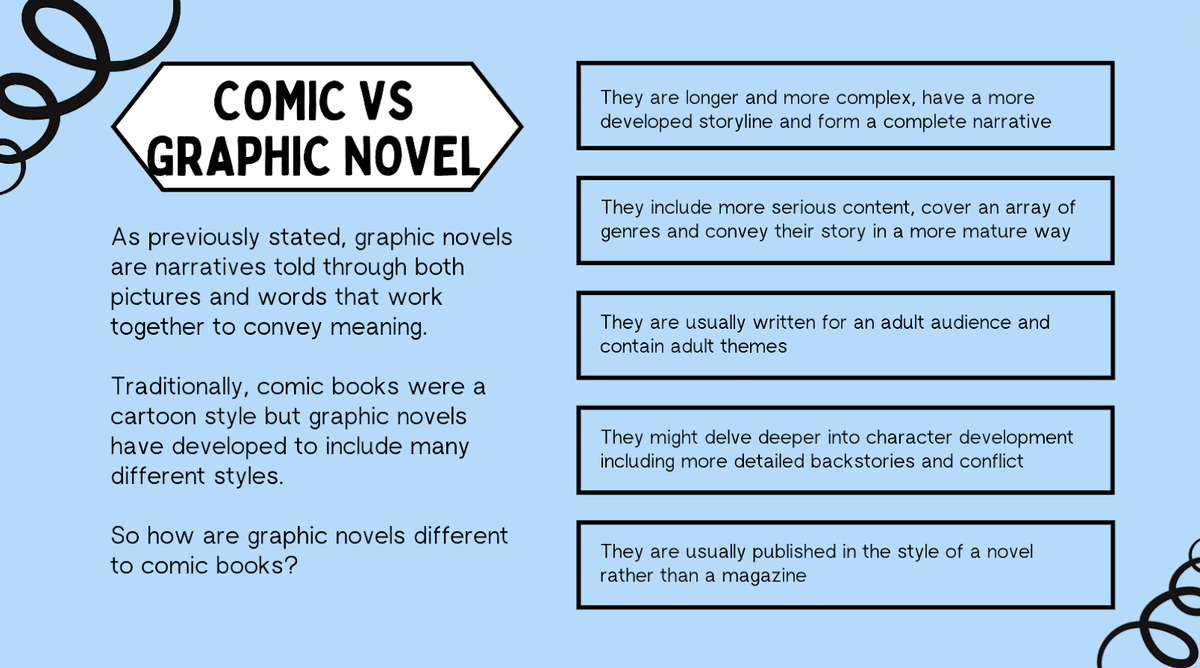

Just like traditional novels, graphic novels help to expand a reader’s vocabulary, comprehension, and literacy. There may be fewer words in graphic novels compared to the lengthy prose of traditional novels, but that does not mean that graphic novels only offer ‘easy or ‘basic’ words or concepts. Graphic novels are limited in the words they can include, so any speech or text is carefully considered to help enlighten the reader as much as possible. Graphic novels also contain complex stories and vocabulary in the same way that traditional novels do, just in fewer words.
There are a wide range of graphic novels in a variety of genres from everything from fantasy fiction to historical non-fiction. This makes graphic novels a great option for people of all ages and reading abilities.
Graphic novels are also perfect as a starting point for both children and adults who do not enjoy traditional reading. The shorter length, smaller word count and enticing imagery help to ensure that children and adults still receive the benefits of reading without having to read thousands of words and lose interest. Reading graphic novels can also inspire a love of reading in those who would have otherwise not picked up a traditional novel.




All St James children are now registered and have received a login and password from the class teacher. Children in the junior school are encouraged to listen to their parents read books from the reading list and have conversations about the text. As the competition progresses parents are encouraged to help their children read together.
The Victorian Government has carefully curated a long list of rich texts for young readers. Please see the booklist attached for books.
Progress of the challenge will be celebrated in fortnightly assemblies and newsletters.


The challenge runs all the way to September and is very attainable for all children.
Children need to read:
Prep to Year 2
Year 3 to Year 6


Most of the books you read should be from the Challenge book lists. The rest can be any book you choose.
You can read books on the book list for your year level or a level above and they'll count towards your Challenge total. You should check with your teachers or parents if you're not in years 9 or 10 and want to read a book from that list. This list includes titles for mature readers.
You can read a book from a level below your year level if your teacher agrees. You still need to read the number of books for your year level to meet the Challenge.


Your teacher will give you a Challenge username and passcode. You should find this in your child’s diary or magic words book where other passwords are located.
If you lose or forget your Challenge passcode,please ask or email Mrs joplin at ajoplin@stjamesbrighton.catholic.edu.au to generate a new one for you.


The dashboard is your main workspace as you progress through the Challenge.
At the top of the dashboard are gemstone badges. These are grey when you start your Challenge. They change to green as you progress through the Challenge.
Below the badges is a green bar. This shows you how many days are left until the end of the Challenge.
There are also two progress wheels that show:
Your reading list shows the books you have added and finished reading.
As you add more books to your reading list, the application will learn the kinds of books you like to read. It will recommend other books by:
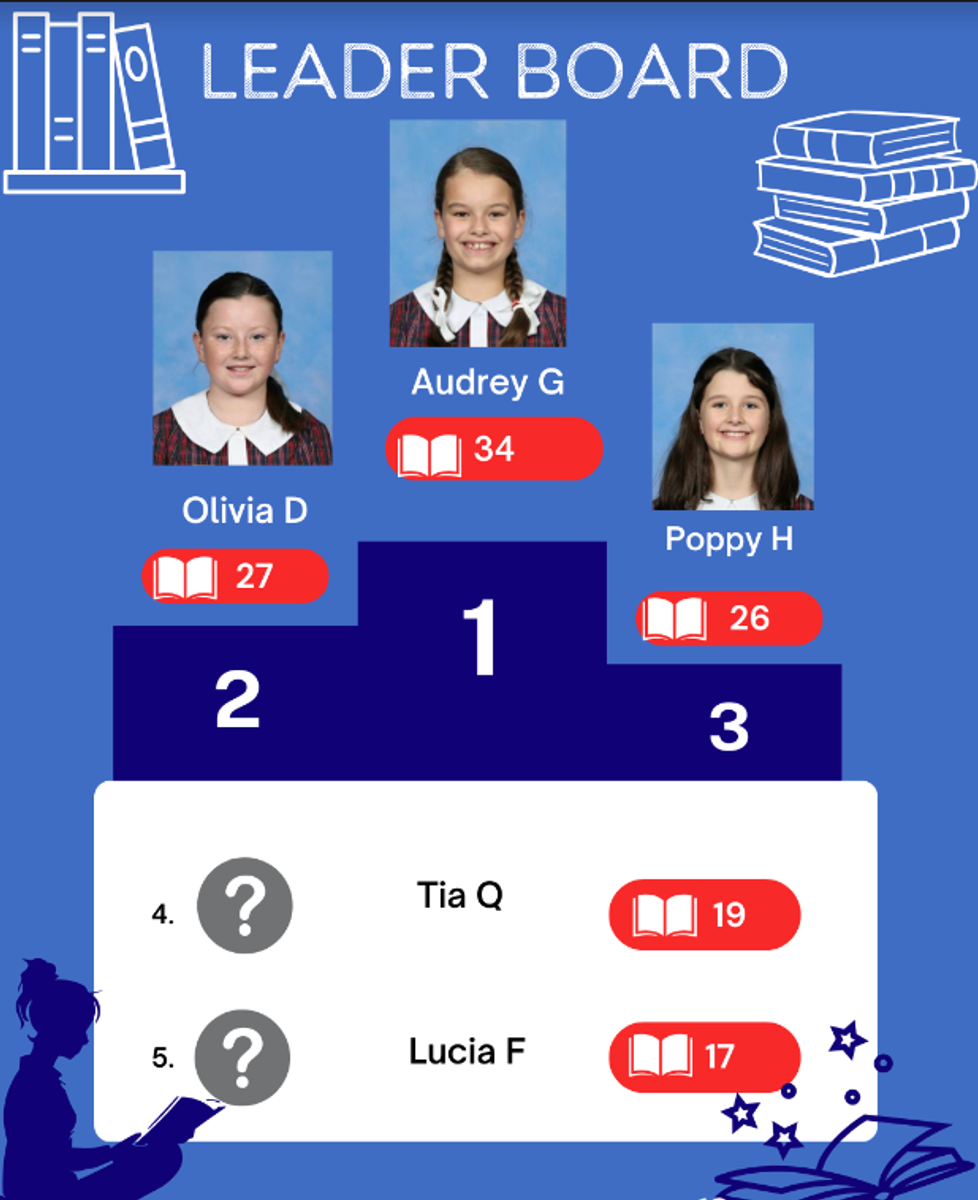

Books other students at your school and across Victoria are reading appear on the Trending books list.
The side menu lets you:
Let’s get reading!!
Mrs Mandi Joplin
Teacher Librarian
Hello Everyone,
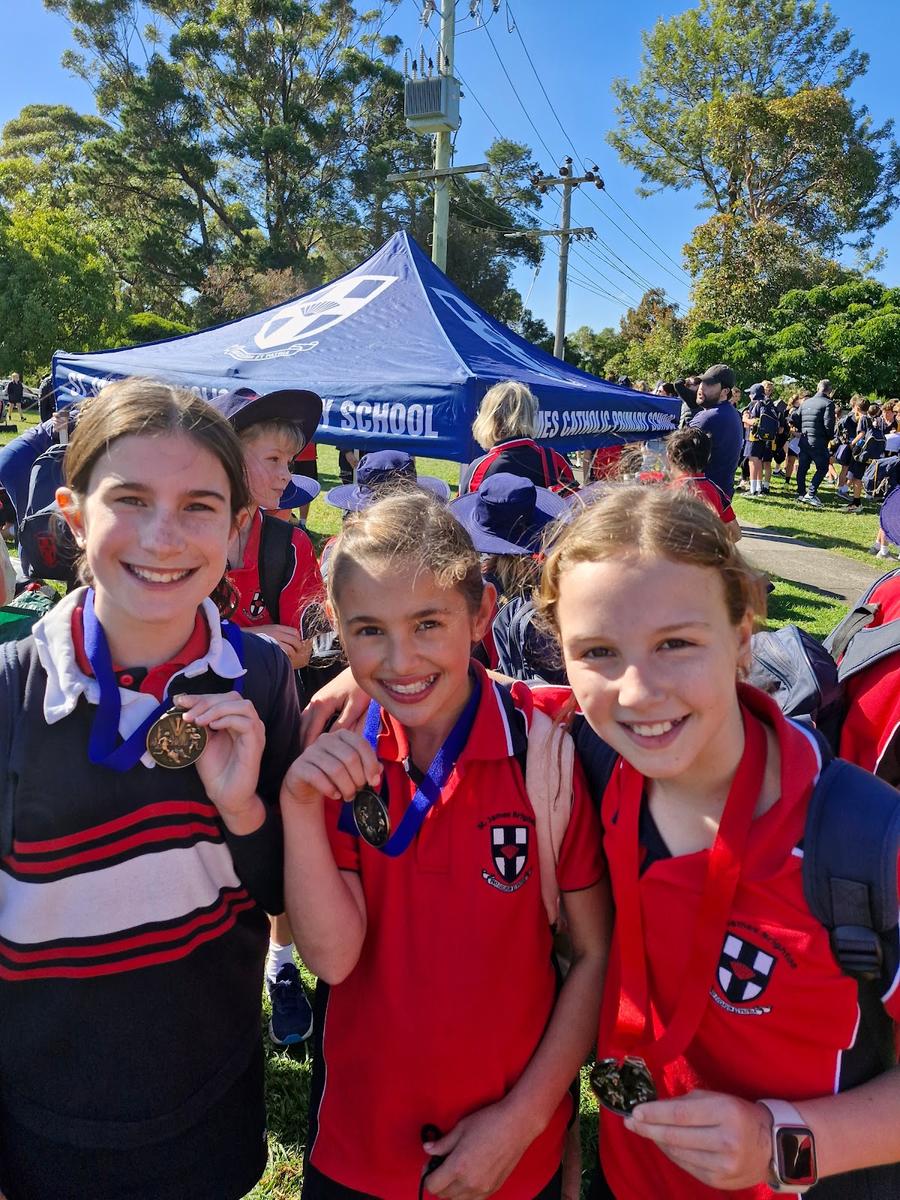

Good luck to our students who finished in the top 8 at the HOLT cross country a couple of weeks ago and will now compete at Beachside next Tuesday 28th May. Tia, Annie, Emily, Ivy, Arran and Delilah we are sure you will do your absolute best!
Friday Sport has continued to be a highlight for our senior students each week. All Year 5 and 6 students were bussed to St Columbus in Elwood where we had 3 Netball teams and one AFL team play. Our AFL students are continuing to show great improvement in their skills each week. Once again a huge thank-you to Dave P (Mila’s dad grade 5) for volunteering to umpire and coach each week. This week was particularly wet in the last quarter that we played, so hopefully he will be back again this week! Our netballers also continue to show great sportsmanship and skill each week and are always very happy with how they have played when they return to the bus.
Thank-you to Maree, Aidan and Emma for your coaching and supporting roles each week.
Friday Sport will be held each Friday until the 7th of June. The following week students will participate in the AFL and Netball Lightning Premierships.
Mrs Georgia McNamara
Deputy Principal - Sport Co-Ordinator/ Senior Physical Education Teacher
Writing
Over the last two weeks, Year 2 have been learning about the power of adjectives in their writing. Adjectives can help the writer paint a picture in the reader's mind.
Here is some Year 2 writing using ‘Adjective Power!’

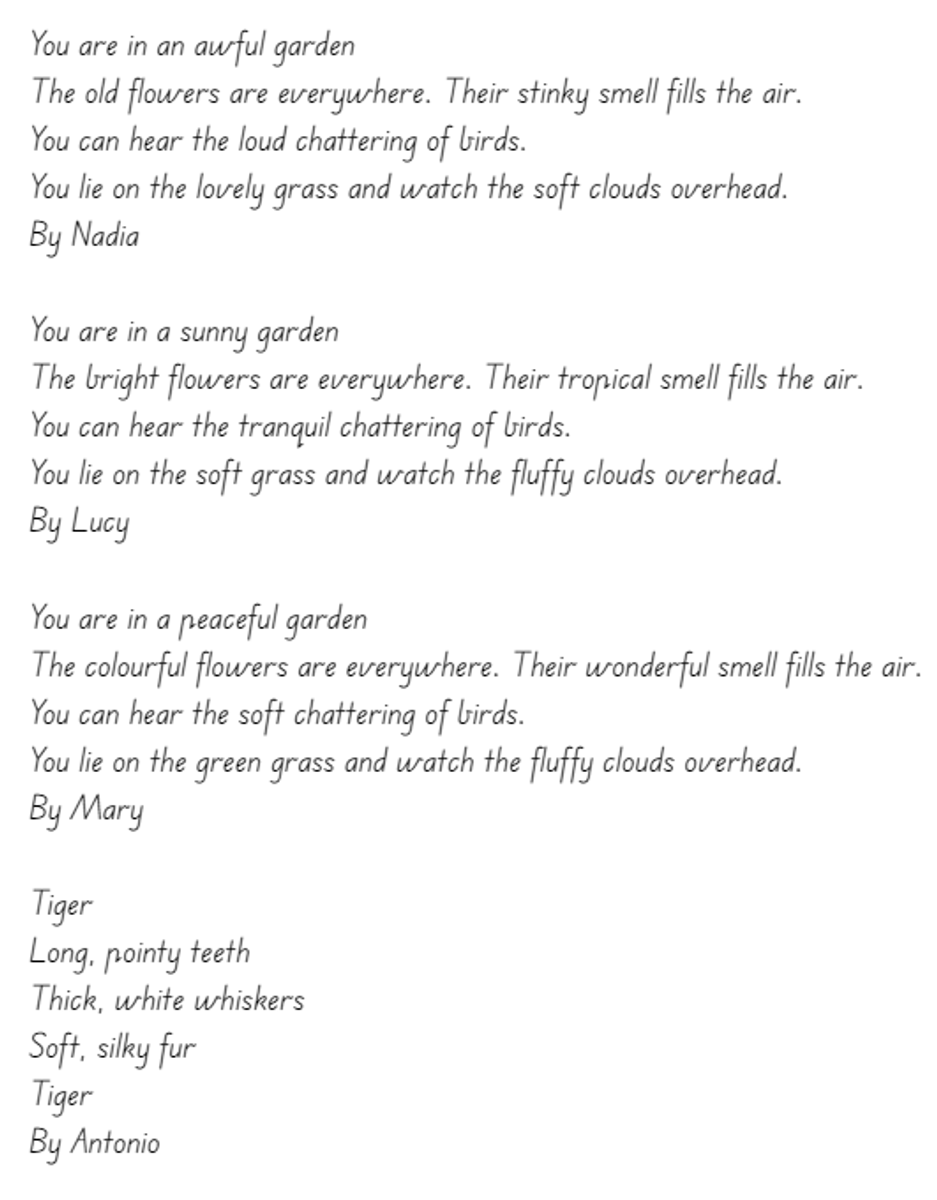


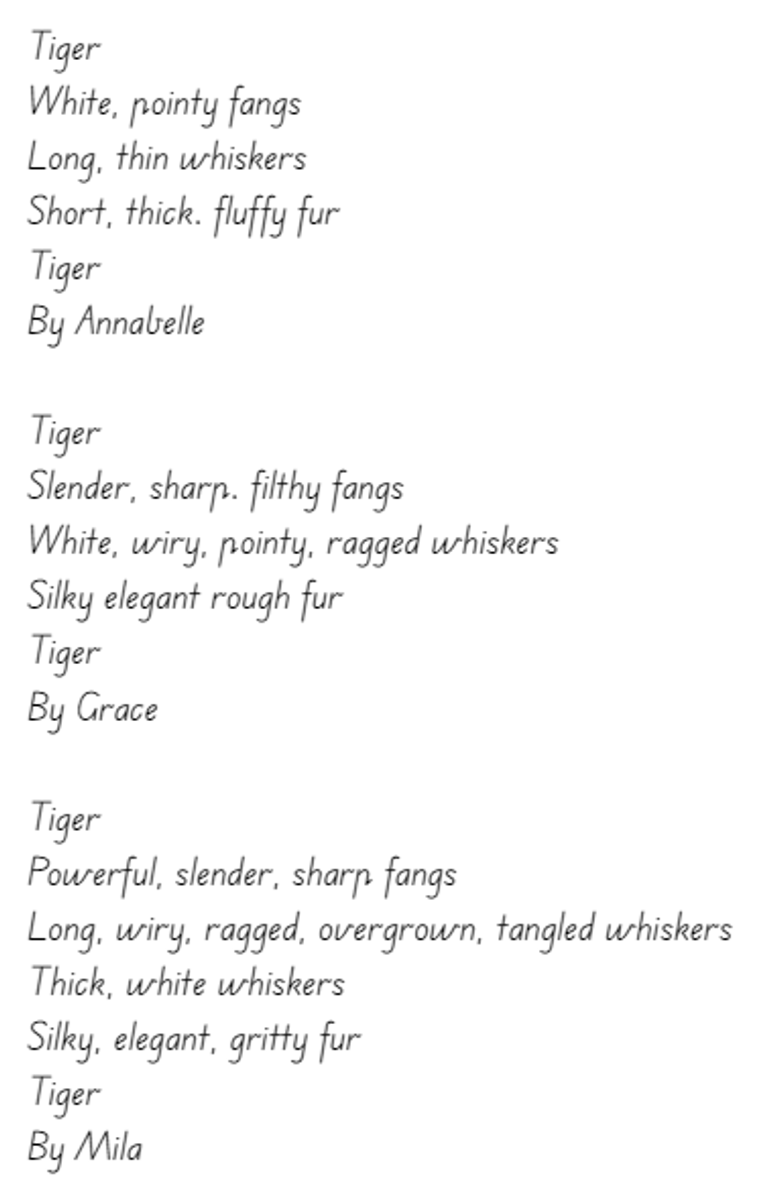
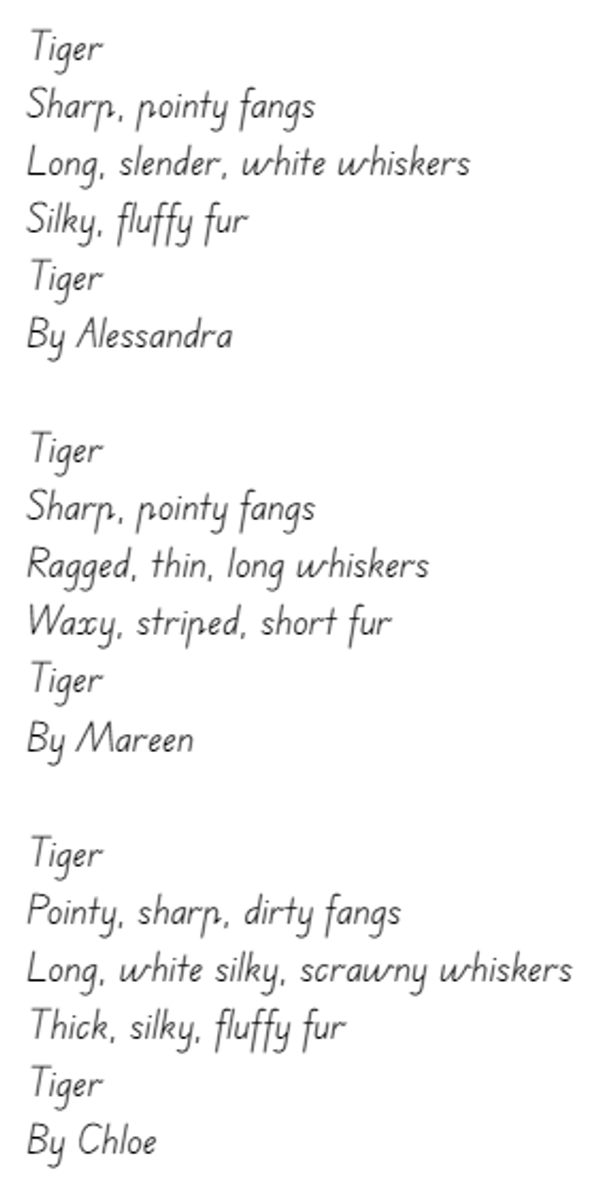


Mrs Cathy Busch
Year 2 Teacher